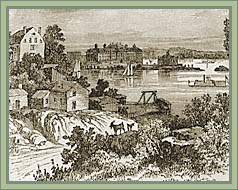In an earlier post, The Declaration of Interdependence, I talked a little bit about how the Rockefeller family tried (once again) to overthrow the United States government (this time, in 1976). Phase One of their plan called for mockingly putting forth a new "Declaration of Interdependence," whose only purpose was to further dilute the U.S. Constitution and to further strengthen the commitment of Washington technocrats to the socialist policies of the United Nations.
Phase Two of their plan called for the adoption of a rather sinister-sounding "Constitution for the New States of America," which the Rockefellers had hoped to showcase at a Constitutional Convention (Con-Con) they were organizing for the weekend of July 4, 1976 in Philadelphia, Pennsylvania. Thankfully, the Con-Con was called off before things got too far out of hand, but the intent of the Rockefeller agenda was clear (as if there was ever any question). In this post, we'll take a closer look at just what this new proposed "Constitution" for America entailed, and at how close we might be to seeing such a horror enacted for real, in our lifetimes.

Rexford Tugwell (in white): FDR technocrat and
principle author, Newstates Constitution of America
The writing of this "new" Constitution got its start over ten years earlier, in 1964, at the deceptively-named Center for the Study of Democratic Institutions in Santa Barbara, California (now based in Los Angeles). The Center is of course a tax-exempt foundation, which basically means that their subversive, treasonous work was paid for by you, the American taxpayer, to the tune of (roughly) $2.5 million annually, for a period of ten years (and our current Constitution cost the taxpayers ..... how much??) The Newstates Constitution took over 100 people more than 10 years and 40 revisions to write. An early draft was circulated among a very select audience in 1970. In 1974, the final copy was quietly published in a book entitled
The Emerging Constitution by Rexford G. Tugwell, the man who helped direct the entire effort.
Today the Center publishes a magazine entitled
New Perspectives Quarterly, which features contributors such as Paul Wolfowitz, Richard Perle and Mikhail Gorbachev. This alone should give a taste of the Center's socialist leanings.
 Robert O. Anderson: Aspen Institute Chairman
Robert O. Anderson: Aspen Institute ChairmanOne of the key aspects of the Newstates Constitution is
regionalism. Just what precisely "regionalism" is, we'll get to in a moment. First, I'd like to take a moment to introduce you to the man who helped define and introduce the concept of regionalism to the United States Government. His name is Robert O. Anderson, who served for 17 years as the CEO of the Atlantic Ritchfield Company (ARCO), and for 21 years as the company Chairman. He retired from ARCO in 1986, after serving for 23 years on the board. Consummate Establishment Insider, Anderson has held a number of other prominent board seats as well, including:
- Federal Reserve Bank of Dallas
- Chase Manhattan Bank
- Columbia Broadcasting Service
- Pan American Airlines
- First National Bank of Chicago
Today he has a business school at the University of New Mexico named after him.
So what precisely is regionalism? Basically, it's exactly the opposite of the federal system by which our country is (at least, in principle) currently governed. In a federal system, all government - to a first order approximation - is local. What local government(s) cannot or choose not to do for themselves, they delegate unto a higher "federating" authority. Nevertheless, under federalism, each locality maintains its own sovereignty and its own decision-making authority and power.
The U.S. Constitution, as it stands today (2005), defines a Union among 50 independent and sovereign States. To what extent each State is truly "independent" and "sovereign" in this day and age is, of course, highly debatable, but what is certain is that in our current model of government, power is designed to percolate up from the people (the ultimate "sovereigns" of America) to the state, and from there to the (federal) Union.
Under regionalism, power emantes from the top, and is imposed upon the people by force. Since power tends to flow better in such a model the more highly concentrated it is, regional planners tend to prefer if their territorial jurisdictions are slightly larger than the States that currently make up the Union. For instance, 10 (tightly controlled) Federal Regions might be preferable to 50 independent (and rambuncious) States.
 The Ten Federal Regions Defined by Nixon's EO 11647
The Ten Federal Regions Defined by Nixon's EO 11647The key takeaway here:
Federalism: Building a nation from the bottom-up
Regionalism: Ruling a nation from the top-down
What does any of this have to do with the real world? On March 27, 1969, President Nixon, through the Government Reorganization Act, created an entirely new (un-Constitutional) kind of government in this country. He merged the 50 sovereign states into eight (subsequently ten) new units that he called "Federal Regions," and claimed that in doing so he was "helping bring government closer to the people."
On February 12, 1972 Nixon further this proclamation by signing Executive Order 11647 which established a Federal Regional Council for each of the ten Federal Regions. Council Chairmen were to report directly to the president, essentially making each of these regions an agency of the federal government. Decision making power was removed from the hands of elected officials and placed in the hands of economic central planners.
I've discussed the dangers of presidential law-making in a previous post,
Lawmaking by Fiat. You can also refer to the excellent study produced by the Cato Institute,
Executive Orders and National Emergencies.
The "capitals" of each of these regions, as per the map above, were defined as follows:
- Region I: Boston
- Region II: New York City
- Region III: Philadelphia
- Region IV: Atlanta
- Region V: Chicago
- Region VI: Dallas-Fort Worth
- Region VII: Kansas City
- Region VIII: Denver
- Region IX: San Francisco
- Region X: Seattle
These 10 Federal Regions were to form the "Newstates" of America, hence the name of the document.
You can read more about Nixon's proclamations on this Web site:
http://www.barefootsworld.net/regional.htmlA few other disconcerting things about the Newstates Constitution (NC) include:
- The Twenty-Five Year Constitution: the NC was to remain in effect only for 25 years, at which point posterity would be left to fend for itself.
- Common Endeavors: the opening words of the NC read "So that we may join in common endeavors," subtly suggesting an end to individual endeavors. There is also no mention of the word "liberty." Rather, the NC seeks "an adequate and self-repairing government."
- Rights Subject to Control: no rights are inalienable, all are subject to control. The practice of religion is a "privilege." Certain key rights, including the right to bear arms and the right to trial by jury, disappear entirely.
- Citizen Responsibilities: the current Constitution is about placing limits on the power of government. The NC is about placing constraints on the freedom of people. For instance, it decrees that "each citizen shall participate in the process of democracy." It is not your choice whether or not to participate, it is a requirement.
- Government by Appointment: Under the NC, the president is elected for one 9-year term. There are two vice-presidents. The president has the power to make treaties, unless the U.S. Senate objects within 90 days (under the current Constitution, the U.S. Senate must explicitly approve all treaties). Under the NC, by the way, the Senate is no longer made up elected representatives at all, but rather is appointed entirely by the president.
- Six Branches of Government: In addition to the three branches that we recognize today, the NC introduces (a) a Police Branch, to enforce the law; (b) a Regulatory Branch, to regulate and plan the economy; and (c) an Electoral Branch, to oversee "elections."
The $25 million Newstates of America Constitution can be read in its entirety here:
http://www.webaccess.net/~comminc/Constitution_1.htmlShould we be worried? Yes and no. The Rockefeller initiative to inaugarate the Newstates Constitution failed miserably back in 1976. Yet Nixon's legacy of regionalism lives on to this day. Funding for most federal agencies, including
FEMA and the
EPA (EPA being another agency created by Nixon), is today distributed as per the Regional Newstates defined in the Newstates Constitution... and as we all know, all you have to do is just follow the money ....






























